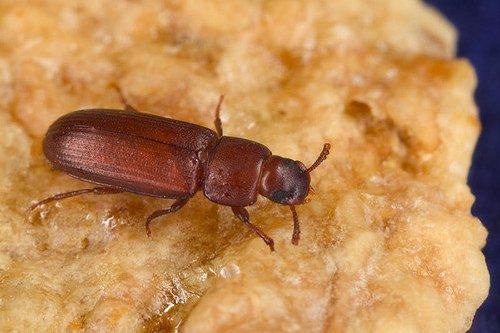December 1, 2010

They're tiny, but, when living and working collectively, destructive.
In the United States, insects destroy as much as 5 percent to 10 percent of stored grains and grain products, said Bhadriraju Subramanyam, a Kansas State University Research and Extension stored-product entomologist.
"The damage translates into a financial loss of $2.2 to $4.4 billion annually," he said.
In developing countries, the loss can range from 30 percent to 50 percent of the crop, with significant losses from insect damage to processed grains reported as well, Subramanyam said.
Insects such as the red flour beetle occur in stored grain, thriving on grain fragments and dust, but prefer floury materials found in flour mills, feed mills, bakeries and food-processing facilities, the stored-product entomologist said.
Red flour beetles are reddish brown in color, and a female can produce as many as 300 to 400 eggs during her five-to-eight-month lifetime. The eggs develop from larvae to adulthood in 30- to 35 days at 86 degrees F.
Common pest
This pest is more common throughout the world than any storage insect pest; it is associated with 246 stored commodities (which is the highest number for a storage insect), and that's why, in grain-processing facilities, most pest management intervention tactics are used primarily to control this prolific pest.
Stored grain and grain-processing facilities can be vulnerable to red flour beetle infestations; processed and packaged grain products, such as cookies, crackers, pet food, etc., that are crushed or otherwise damaged during warehousing or other storage and transit to the point of sale also can be vulnerable.
Subramanyam, who goes by "Subi," is candid in speaking of potential losses, but also intent on focusing his research to seek environmentally-friendly solutions to reduce -- and eliminate -- insect damage to stored grains and grain products caused by the red flour beetle.
Previous treatments in grain-processing facilities have relied on methyl bromide, which, while 99 to 100 percent effective in reducing adult and immature infestations, has been classified as an ozone depleting chemical and has been phased out in the United States and other developed countries except for certain critical (pre-shipment and quarantine) uses, Subramanyam said.
Alternatives to methyl bromide in grain-processing facilities include sulfuryl fluoride and heat, and Subramanyam has worked with both since joining K-State in 1999. He and collaborators in Grain Science and USDA’s Center for Grain and Animal Health Research have completed side-by-side comparisons of all three treatments during 2009-2010 at the Hal Ross pilot flour mill at K-State, which, as a state-of-the-art facility, enabled demonstrating, for the first time, the cost-effectiveness of methyl bromide and its alternatives.
Simple concept
Heat is not a new technology -- its benefits in killing flour mill insects were first demonstrated in Kansas by George Dean in 1911. Several grain-processing facilities have used heat treatment successfully for at least six decades, and it is one of the effective options for organic grain-processing facilities.
"The concept is very simple," said the entomologist, who explained that "insects are cold-blooded, so raising the temperature beyond their upper limit for survival and reproduction (usually above 110 degrees F) results in death; how quickly and how many one kills insects depends on reaching 122 degrees F in 8 to 10 hours and maintaining temperatures between 122 and 140 degrees F for several hours."
Sulfuryl fluoride, a non-ozone depleting fumigant, was registered for use in grain-processing facilities in January 2004 as a methyl bromide alternative.
According to Subramanyam, methyl bromide is a fantastic fumigant the grain-processing industry has relied on for nearly six decades.
Viable solutions
While heat and sulfuryl fluoride may never fully replace methyl bromide’s spectrum of effectiveness against various insect pests, K-State research has shown that both heat and sulfuryl fluoride are viable non-ozone depleting alternatives for the foreseeable future.
Now, the researchers have shifted focus from these techniques to using aerosols (fogging), because many flour mills are successfully using aerosols in heavily infested rooms and avoiding the costly whole-structure treatments with methyl bromide, heat or sulfuryl fluoride. However, limited studies show the benefits of aerosols in managing all life stages of the red flour beetle.
Much of the research with aerosols at K-State will be conducted at the Hal Ross Flour Mill, part of the Grain Science Complex on the Kansas State University Campus, and additional tests will be performed in commercial grain-processing facilities.
The methyl bromide alternatives research is a collaborative effort between K-State scientists, Dirk Maier and Subramanyam from the Department of Grain Science and Industry and Michael Langemeier, the Department of Agricultural Economics; USDA’s Center for Grain and Animal Health Research Scientists Paul Flinn, Frank Arthur and James Campbell; Brian Adam, from Oklahoma State University’s Department of Agricultural Economics; and Linda Mason, from the Department of Entomology, Purdue University.
To read more about the more technical side of the research and funding, go to http://www.ksre.ksu.edu/news/story/control_insects090910.aspx to see a companion K-State Research and Extension news release: ”K-State, USDA, and OSU Researchers Seek Best Ways to Control Insects in Warehouses, Food Processing Facilities.” In addition, an audio slide story on Subramanyam’s work is available at http://www.ksre.ksu.edu/news/DesktopDefault.aspx?tabid=128.
For more information about the current research, contact Subramanyam at [email protected].
You May Also Like




